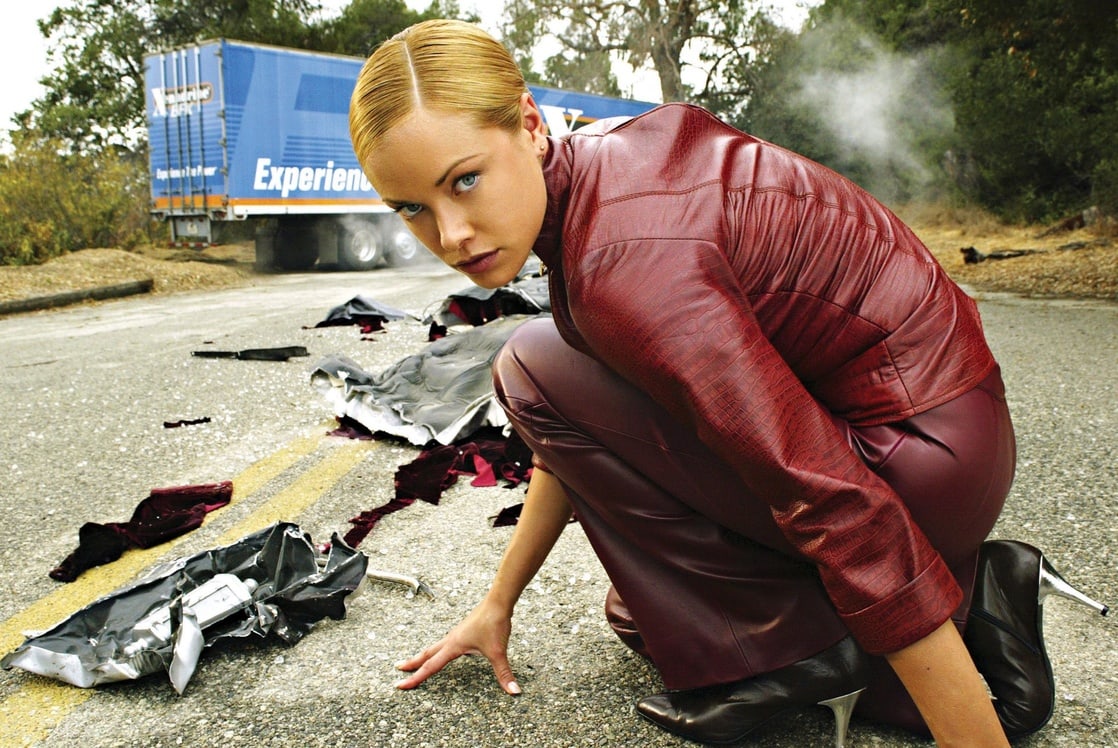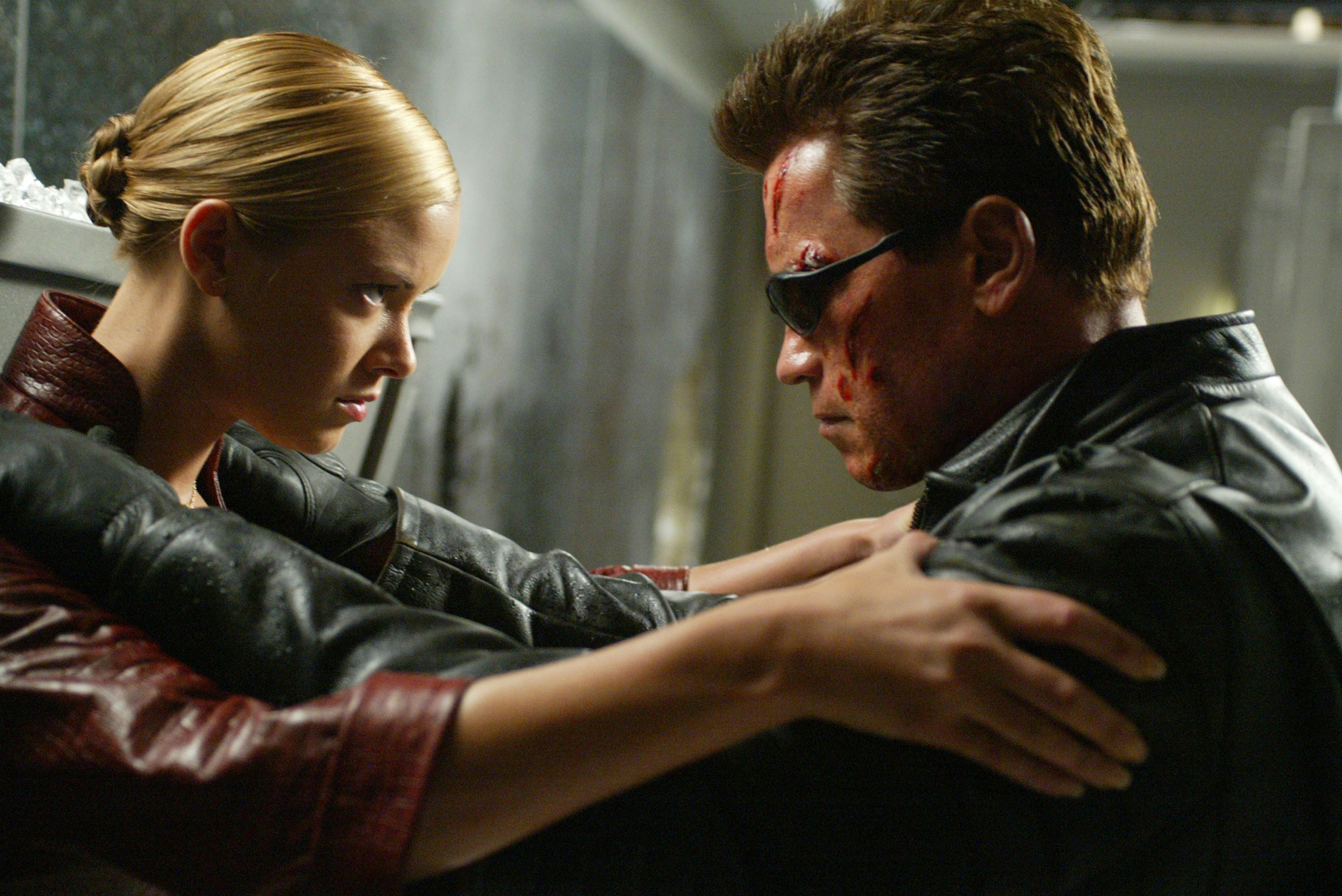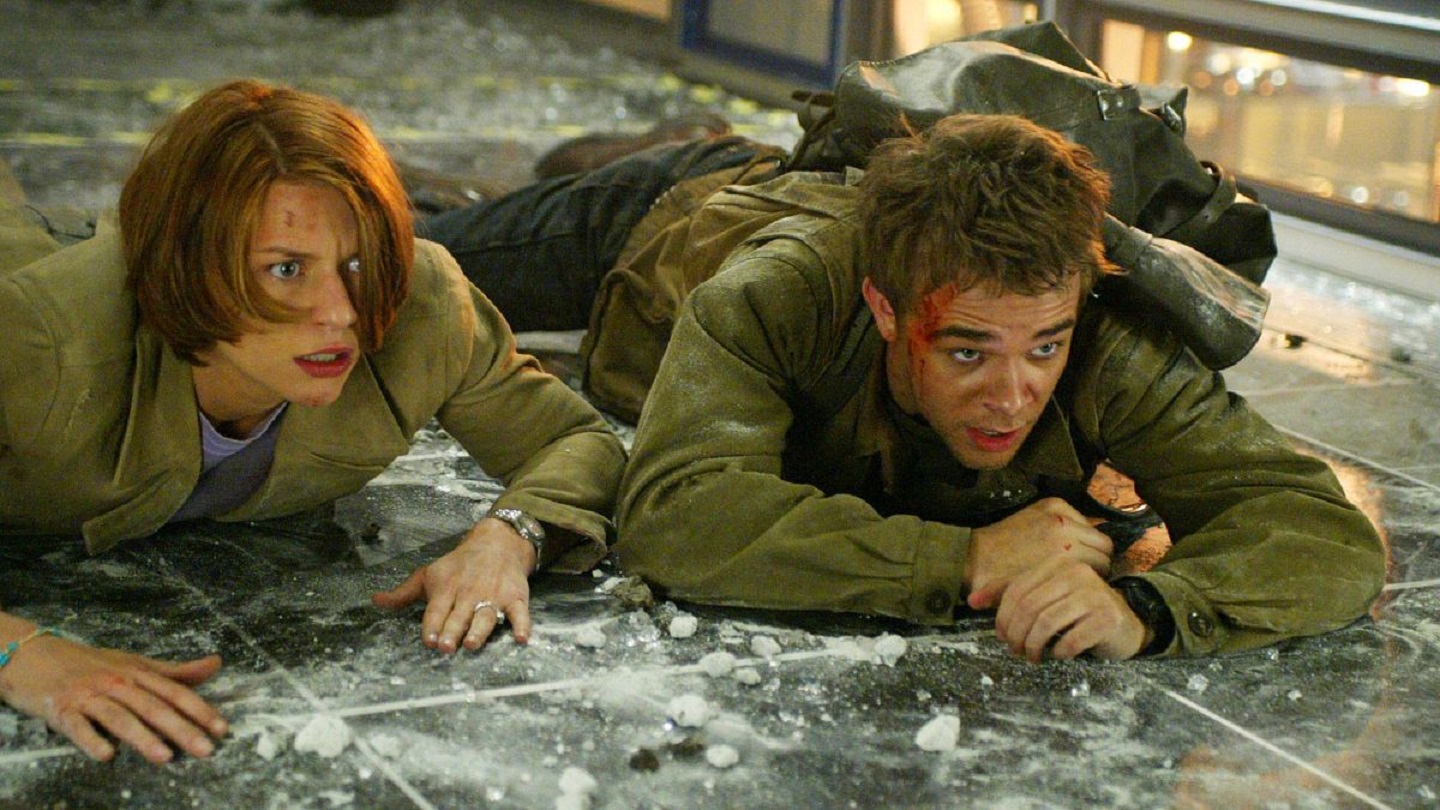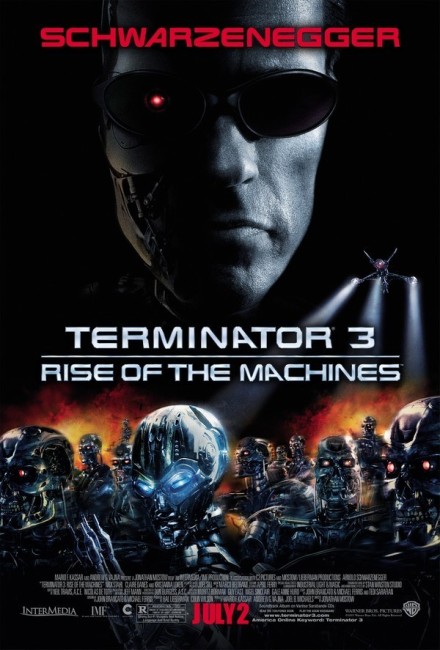USA/Germany. 2003.
Crew
Director – Jonathan Mostow, Screenplay – John Brancato & Michael Ferris, Story – John Brancato, Michael Ferris & Tedi Sarafian, Producers – Matthias Deyle, Hal Lieberman, Joel B. Michaels, Andrew J. Vajna & Colin Wilson, Photography – Don Burgess, Music – Marco Beltrami, Visual Effects Supervisor – Pablo Helman, Digital Animation Supervisor – Dan Taylor, Visual Effects – Digiscope (Supervisors – Dion Hatch & Don Hees), Hydralux, Industrial Light and Magic, New Deal Studios (Supervisor – Ian Hunter), Riot & Sandbox Pictures (Supervisor – John P. Wright), Special Effects Supervisor – Allen Hall, Makeup Effects/Animatronics – The Stan Winston Studio (Supervisor – John Rosengrant), Production Design – Jeff Mann. Production Company – InterMedia/C2 Pictures/IMF Internationale/Mostow-Lieberman Productions.
Cast
Nick Stahl (John Connor), Arnold Schwarzenegger (The Terminator), Claire Danes (Kate Brewster), Kristanna Loken (The T-X), David Andrews (General Robert Brewster), Mark Famiglietti (Scott Mason)
Plot
A new Terminator android The T-X, build with a female body and a deadly arsenal of weapons, arrives back in present-day Los Angeles in search of John Connor. At the same time, a familiar, old model Terminator also arrives to protect him. In order to stay alive, John now lives homeless and outside the law. He breaks into a veterinary clinic in search of medicine and is found by Kate Brewster where the two of them realize they went to school together. They are propelled into the battle between the two Terminators where Kate is shocked to realize her destiny is as John’s future wife and lieutenant. John realizes that the threat of Skynet has not been ended, merely been postponed. Meanwhile, a computer virus is infecting all internet and cellular systems and so the top military brass order Kate’s father, a general, to turn Skynet on in an effort to clear the virus out of the system. With the AIs active, John and Kate race to stop the countdown before Skynet launches Judgment Day in three hours time.
James Cameron’s two Terminator films, The Terminator (1983) and Terminator 2: Judgment Day (1991), are modern science-fiction and action movie classics. With The Terminator, Cameron did miracles on a B-budget and established himself at the frontline of modern directors, while also consolidating Arnold Schwarzenegger as the No. 1 action name of the 1980s. With Terminator 2: Judgment Day, Cameron expanded the scale of the action out to a mind-boggling degree, making the film the template for the modern action blockbuster and creating the revolution in CGI effects. After this, a Terminator 3 was probably an inevitable given – there were certainly been numerous spec fan scripts floating around out on the internet for years.
That James Cameron divorced himself from any involvement with Terminator 3: Rise of the Machines should probably say exactly one should expect from the finished product. Terminator 3 is instead made out of the copyright licence shared by Gale Anne Hurd, James Cameron’s ex-wife and co-producing partner on the first two films. Gale Anne Hurd established herself as a strong producing presence in conjunction with Cameron on the likes of The Terminator, Aliens (1986) and The Abyss (1989). Alas, Hurd’s solo career since they parted ways has been sporadic. She has made occasional gems like Tremors (1990) and the tv movie Cast a Deadly Spell (1991), but mostly turned out would-be Cameron-esque spectacles like No Escape/Escape from Absolom (1994), Dante’s Peak (1997), Armageddon (1998) and Virus (1999) that failed to impress. On the other hand, the 2000s were kinder to Hurd and she bounced back with several Marvel Comics adaptations and the hit tv series The Walking Dead (2010– )
Most of the original cast members – Linda Hamilton, Michael Biehn or Robert Patrick – deigned to be involved in Terminator 3: Rise of the Machines. (Edward Furlong probably would have but was passed over as he had been getting in trouble with the law for drug possession). The only returnee was Arnold Schwarzenegger. While the first Terminator film made Arnold Schwarzenegger a major star, his career has been in a decline throughout the latter half of the 1990s with his last handful of trademark action movie outings – Last Action Hero (1993), Eraser (1996), End of Days (1999), The 6th Day (2000) and Collateral Damage (2002) – proving to be less-than-stellar hits. Furthermore, in 1999, Premiere magazine conducted a devastating evisceration of Schwarzenegger, showing him up to be a crude womaniser and an abuser of aides, which did much to tarnish his image. Not to mention his willingness to step into the dirty business of the California governor’s recall race in the Republican bid to unseat Governor Gray Davis around the same time that Terminator 3 premiered. The truth is that Schwarzenegger has been looking for a hit for the better part of the 1990s. The fact that he reportedly forewent $1.4 million of his salary so that the crane mass destruction sequence could be completed is telling. For a star to be so personally involved in a production is almost unprecedented, the fact that Schwarznegger himself is so determined that what should be on show is a massive spectacle is surely telling of the worry that underlies his motives.

For all that, one did not expect Terminator 3: Rise of the Machines to emerge as badly as it does. One strains to think of even a single thing about it that does work. The creative control of the sequel has been turned over to wannabes. The new director is Jonathan Mostow who had started out making the inane Beverly Hills Body$natchers (1989), had made a couple of okay films, the thriller Breakdown (1997) and U-571 (2000), which was passable so long as one set its complete fictionalisation of history aside. The script comes from writing team of John Brancato and Michael Ferris, who had previously turned out such undistinguished fare as the woefully dull hacker thriller The Net (1995) and David Fincher’s disappointing The Game (1997) and subsequently went onto the dire Catwoman (2004) and the killer crocodile film Primeval (2007). Mostow, Brancato and Ferris did however subsequently combine on one fine science-fiction film with Surrogates (2009).
What is so disappointing about Terminator 3: Rise of the Machines is thinking about it in comparison to Terminator 2. Between Terminator‘s 1 and 2, James Cameron expanded the scope and scale of the film a hundredfold, building a ferocious and energetic B action film out into a groundbreaking spectacle. There is nothing in Terminator 3 that takes that same quantum leap out beyond its predecessor, the film rarely looks like anything more than a well-budgeted attempt to copy either of the originals.
For one, there is something incredibly limited about the concept. The only novelty spin Terminator 3 has is to recast the basic plot of Terminator 2 – rewired Terminator comes back to help John Connor against an evil Terminator – with a female Terminator instead of Robert Patrick’s T-1000. The T-1000 in Terminator 2 was such a stunning concept that the T-X here cannot help but seem a retrograde step. I mean, after a liquid metal Terminator that can turn into any kind of shape, where you can you possibly go to top that? The female Terminator seems merely a gimmick spin – you can bet that anything she could do, the T-1000 could in its sleep. The gadgets that she is outfitted with – an arm that pops out a raygun and a flamethrower, the ability to sniff DNA and remotely control a squad of police cars to pursue the heroes – seems merely gimmicks that belong more to some killer robot in a comic-book.
Model Kristanna Loken looks occasionally lithe and menacing dressed in red leather as The T-X. However, as a threat, her character seems barely there – she seems trivially negligible as a nemesis, certainly has none of the cold menace that Robert Patrick projected in Terminator 2 or the imposing implacability that Arnold Schwarzenegger did in the original. You also keep wondering about some of the logic of the design of the T-X – if she can shapechange and alter her appearance, why does she have excess hair that needs to be kept up in a bun? Why does she need to kill a motorist to get her clothes if, when she emerges after being crisped in a fire, she demonstrates an ability to reconstitute clothing out of her artificial skin? Also Jonathan Mostow tends to directs her as a villainess rather than as an android – where both Schwarzenegger and Robert Patrick were perfectly emotionless killing machines in the other films, she is allowed a series of entirely human supercilious smiles.

More importantly, there is none of the character drive that made Terminator 2 fascinatingly soulful. There James Cameron crafted the bond between John Connor and the Terminator as a unique metaphor for father and son relationships. There is none of that here. And where Terminator 2 was a film of ambitiously driving morality with a pacifist message that questioned the very nature of the mass violence on display, Terminator 3 is merely a big budget special effects show where no such questions ever assail its horizons.
Every scene in Terminator 3: Rise of the Machines seems derivative and desperately unoriginal. There is barely a single action sequence that is not copied from either of the other Terminator films – cop car chases; a scene with the bad Terminator driving a heavy vehicle in pursuit of John Connor and the good Terminator as they flee in a rickety small vehicle causing a wake of mass destruction; a shootout between Arnold Schwarzenegger’s Terminator and armed SWAT teams gathered outside a building, with the Terminator deliberately not hurting human lives; the break-in to a hi-tech facility to stop Judgement Day; the good and bad Terminators fighting it out and damaging one another, leaving Schwarzenegger fatally damaged but eventually able to reroute his systems; The Terminator killing its way through the L.A. phone directory; even the character of a young, single woman who is innocently drawn into the fray and discovers that she is to become the partner of a rebel and play an active part in the future resistance against the machines.
Worst though, what Mostow, Hurd et all allow Terminator 3: Rise of the Machines to do is turn into a pastiche of a Terminator film. They are constantly taking the audience’s familiarity with the clichés and lines of the originals and poking fun at them. Arnold Schwarzenegger’s Terminator goes through the process of learning colloquialisms again – but this time it’s “Talk to the hand.” There is a running joke throughout about Schwarzenegger’s attempts to keep himself attired in a pair of shades. The film parodies Schwarzenegger’s catchphrase “I’ll be back,” which goes through various permutations to emerge as “She’ll be back” and “I’m back.” The trouble was that Schwarzenegger heartily spoofed the same very line in Last Action Hero and the effect here is of a film that has side-slipped into in-joking in-referentiality. Even worse is the scene where Schwarzenegger gets his clothes. Now the scene where the naked Terminator walks up to a biker and says “Give me your clothes” has turned into a scene where Schwarzenegger walks into a strip club and demands the same of a stripper, only to end up in biker leathers and a pair of florally over-ornamented glasses like a refugee from a Village People performance. The unfortunate upshot of this is a Terminator film that is dangerously close to self-parody, one where the only original moves it throws on everything that has gone before is to quote its own lines back to a waiting audience with tongue planted in cheek and deflate its action hero’s tough guy status with not-very-funny gay jokes.
On all fronts, Terminator 3: Rise of the Machines is a stupid film. There are logic holes everywhere. Skynet was supposed to be destroyed at the end of Terminator 2 but is an active program here. The film is woefully uninformed about how computers work – one of the big surprises is that Skynet is supposed to be a program that has no central CPU, which leads to the kind of obvious question – where is it housed? The film offers up the vague notion of Skynet being housed in cyberspace but cyberspace is not an actual physical place, merely a series of interlinked computers. Occasionally, the film seems on the verge of stumbling towards some decent ideas – like the revelation that the good Terminator will be responsible for John Connor’s death. There is a surprising downer of an ending, although the cynic in one keeps thinking that this is merely a set up from the inevitable Terminator 4.

The few original action sequences that the film comes up with with jet planes flying around corridors and missiles and vehicles exploding in rooms and hallways (and the explosion failing to even ruffle the clothing of a person standing 10 feet away) are woeful. There is nothing about any of the action sequences that keeps one on the edge of their seats as the sequences in either preceding film did, they seem merely mass destruction for the sake of it. James Cameron’s action sequences had a scale to them that was utterly stunning; these are routinely spectacular in a way that is almost forgotten by the time the film is over.
The Industrial Light and Magic effects are surprisingly dull and uninspiring. The mass devastation as Judgement Day arrives is staggeringly unambitious in scale – compared to the holocaust sequence in Terminator 2, the scenes with the robot planes flying around the corridors and a half-ruined L.A. out the window look like B-budget CGI. When one considers that Terminator 3: Rise of the Machines had a $170 million budget – which is $70 million more than Terminator 2 (which was the most expensive film ever made when it came out) – the result is one of the tattiest looking $100 million + films that has graced screens in recent years.
As a replacement for Edward Furlong, Nick Stahl is laughably bad. Where Furlong had a brash, sneeringly defiant youthfulness in his performance, Nick Stahl seems merely pouty and straining to convey any expression at all. When one tries to imagine the tough, charismatic rebel leader of the future that John Connor is supposed to be, Stahl’s casting seems even more ludicrously out of its depth. His is toughness that barely even seems to extend to convincing designer stubble. Not that Nick Stahl is a bad actor either – he has conducted sterling work elsewhere in Bully (2001) and the fine tv series Carnivale (2003-5).
Next up, the Terminator films were spun out into the tv series The Sarah Connor Chronicles (2008-9), although this pretended that the events of Terminator 3 never happened. After much debate, Terminator Salvation (2009) was finally produced and is a somewhat better sequel, featuring Christian Bale as John Connor fighting in the future. This was followed by the disastrous Terminator Genisys (2015) with a return appearance from an aging Arnold Schwarzenegger; and Terminator: Dark Fate (2019) with return appearances from Arnold Schwarzenegger and Linda Hamilton.
(No. 8 on the SF, Horror & Fantasy Box-Office Top 10 of 2003 list).
Trailer here

